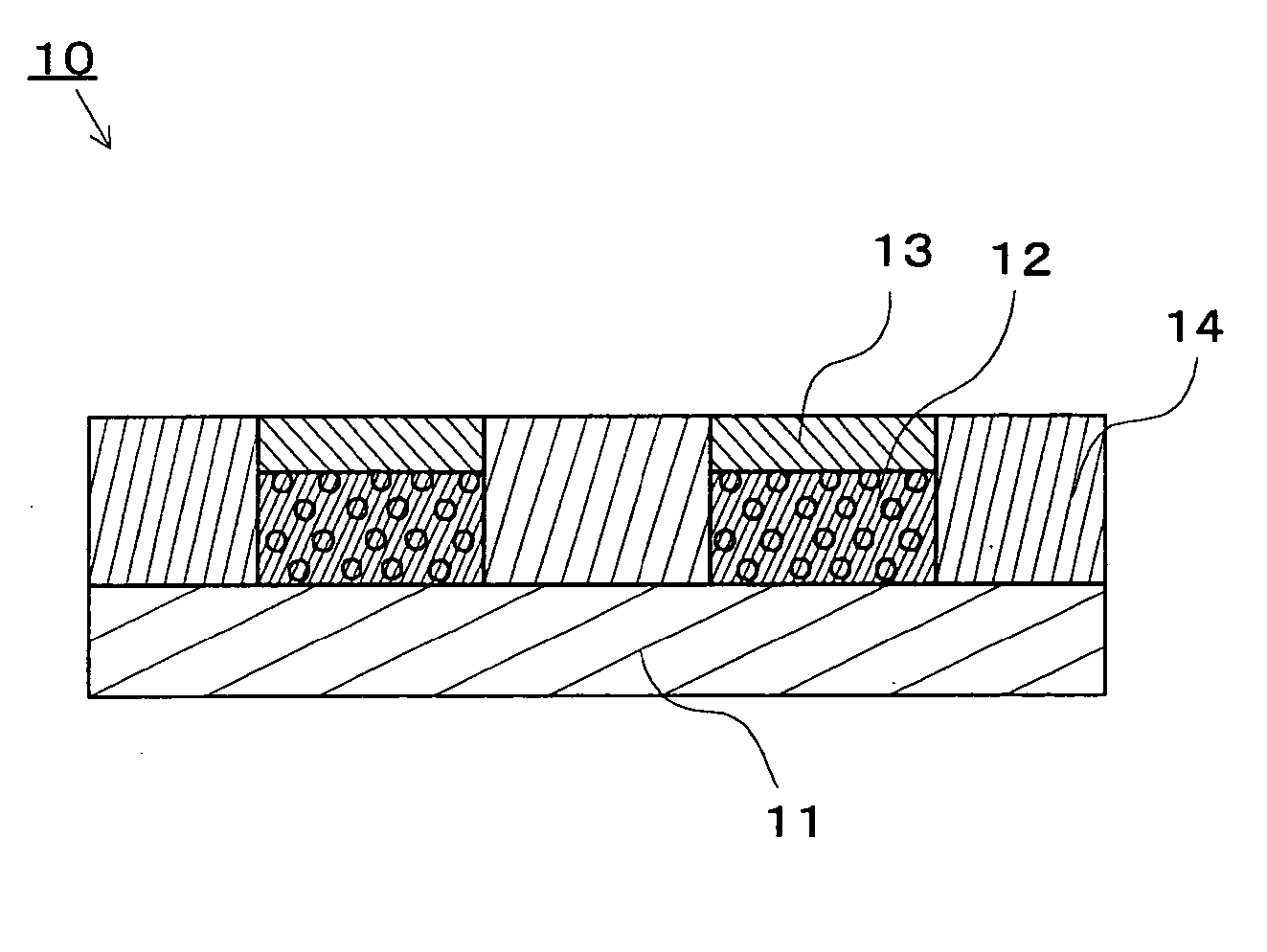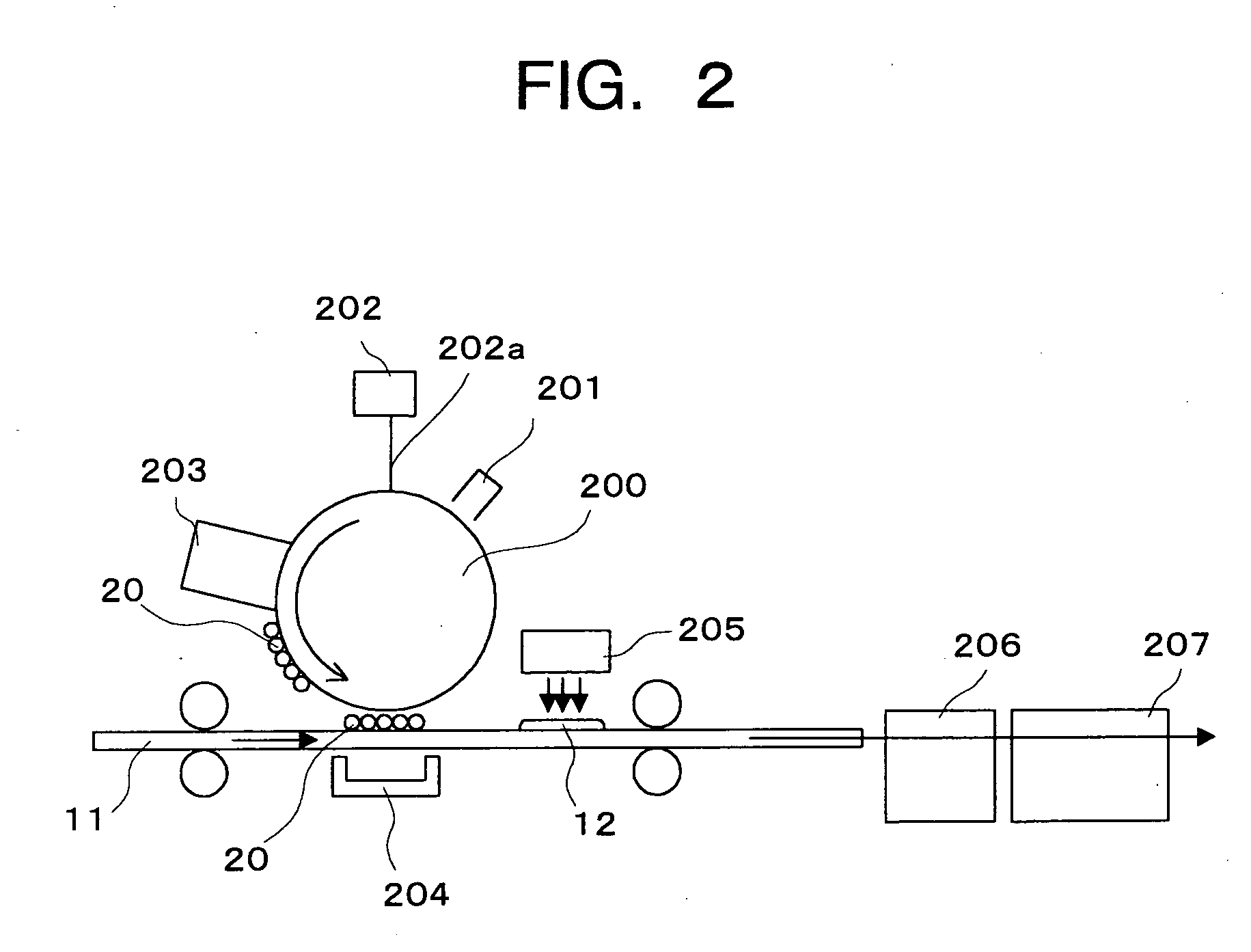Wiring board and multilayer wiring board
a multi-layer wiring board and wiring board technology, applied in the direction of metallic pattern materials, electrography/magnetography, synthetic resin layered products, etc., can solve the problems of long mask production period, considerable cost of multi-layer wiring board manufacturing, and special mask production
- Summary
- Abstract
- Description
- Claims
- Application Information
AI Technical Summary
Benefits of technology
Problems solved by technology
Method used
Image
Examples
first embodiment
[0027] (First Embodiment)
[0028]FIG. 1 schematically shows a cross-sectional view of a wiring board 10 composed of a single layer of the first embodiment of the present invention.
[0029] The wiring board 10 is composed of a base material 11, a nonconductive metal-containing resin layer 12 selectively formed on the base material 11, a conductive conductor metal layer 13 formed on the metal-containing resin layer 12, and a resin layer 14 selectively formed on the base material 11.
[0030] An example of the forming process of the wiring board 10 will be described with reference to FIG. 2 and FIG. 3.
[0031]FIG. 2 is a view schematically showing the forming process of a conductor pattern of the first embodiment of the present invention. FIG. 3 is a view schematically showing the forming process of an insulating pattern of the first embodiment. Further, FIG. 4 shows a cross-sectional view schematically showing a metal-containing resin particle 20 forming the nonconductive metal-containing r...
second embodiment
[0065] (Second Embodiment)
[0066]FIG. 6 shows a cross-sectional view of a multilayer wiring board 30 of a second embodiment formed by alternating-the above-described conductor pattern forming process and insulating pattern forming process. Note that the same reference numerals are assigned to the same portions as those in the configuration of the wiring board 10 of the first embodiment and the explanation thereof will be omitted. The multilayer wiring board 30 of the second embodiment is formed by the electrophotographic system in the similar manner to the wiring board 10 of the first embodiment.
[0067] A first layer constituting the multilayer wiring board shown in FIG. 6 is composed of a base material 31, a nonconductive metal-containing resin layer 32 selectively formed on the base material 31, a conductive conductor metal layer 33 formed on the metal-containing resin layer 32, a resin layer 34 selectively formed on the base material 31 and the conductor metal layer 33, and a via ...
third embodiment
[0092] (Third Embodiment)
[0093]FIG. 10 shows a cross-sectional view of a multilayer wiring board 50 of a third embodiment formed by alternating the above-described conductor pattern forming process and insulating pattern forming process. Note that the same reference numerals are assigned to the same portions as those in the configuration of the first and second embodiments and repeated explanation thereof will be omitted. The multilayer wiring board 50 of the third embodiment is formed by the electrophotographic system as in the first and second embodiments.
[0094] The multilayer wiring board 50 shown in FIG. 10 includes a base material 51 having at least one through hole 57 opened, nonconductive metal-containing resin layers 52 selectively formed on the front and rear faces of the base material 51, conductive conductor metal layers 53 formed on the metal-containing resin layers 52, and a conductor portion 54 provided in the through hole 57 which electrically connects the respective...
PUM
| Property | Measurement | Unit |
|---|---|---|
| diameter | aaaaa | aaaaa |
| diameter | aaaaa | aaaaa |
| diameter | aaaaa | aaaaa |
Abstract
Description
Claims
Application Information
 Login to View More
Login to View More - R&D
- Intellectual Property
- Life Sciences
- Materials
- Tech Scout
- Unparalleled Data Quality
- Higher Quality Content
- 60% Fewer Hallucinations
Browse by: Latest US Patents, China's latest patents, Technical Efficacy Thesaurus, Application Domain, Technology Topic, Popular Technical Reports.
© 2025 PatSnap. All rights reserved.Legal|Privacy policy|Modern Slavery Act Transparency Statement|Sitemap|About US| Contact US: help@patsnap.com



